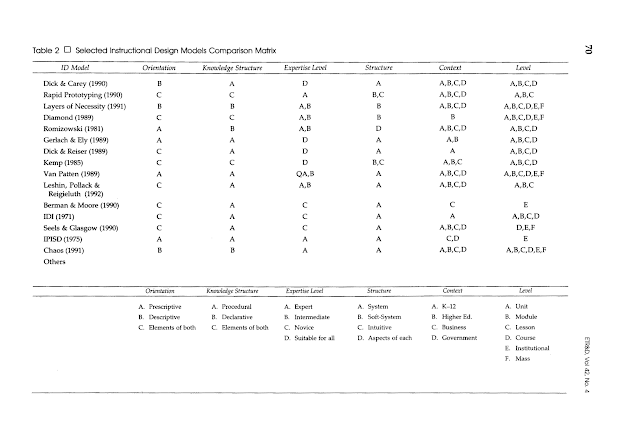Which model to choose?
In the world of
instructional design models, it can be overwhelming trying to decide which
model to choose. A contemporary conceptual frame of reference, that
incorporates a consideration of designer expertise, contexts, traditional
approach to instructional design, as well as emerging approaches to
instructional design, for comparing instructional design models at this point
becomes necessary (Edmonds, et. al, 1994).
In their article, “A Conceptual Framework for Comparing Instructional Design Models,” Gerald S. Edmonds, Robert C. Branch, and Prachee Mukherjee discuss the need to create a frame of reference for all instructional design models. There paper emphasizes that this is not an argument for more instructional design models, but rather, a call for ways of comparing existing instructional design models and new models as well.
The authors state that instructional design models share a number of common characteristics, such as categorization, context, and level, in addition to prescriptions about information arrangement and sequence. Categorization, context, and level of models can be used to classify various kinds of approaches to instructional design.
Constructing a Conceptual Framework
There
is a plethora of existing instructional design models. This can make it
confusing for an instructional designer to choose without having to study each
model in detail. Instructional design scholars should be able to form critical
opinions about divergent instructional design models, compare and contrast
them, and build meta theories to address the complexities of instructional
situations (Edmonds, et. al, 1994).
Edmonds, Branch, and Mukherjee bring up the emergence of five factors that currently influence instructional design theory and practice:
Determining the purpose of a modelDetermining the context for which the model is intendedDetermining the level of experience the designer should have in order to apply the modelDetermining whether the model adopts a systems-theory approach or alternative approachDetermining the type of learning tasks the model will support
These five emerging factors are integrated into the conceptual framework the authors offer in their article. From there, the proposed framework is centered on four classifications:
Type of Orientation: Prescriptive or DescriptiveType of Knowledge: Procedural or DeclarativeRequired Expertise: Novice, Intermediate, or ExpertTheoretical Origins: Hard systems, Soft systems, or Intuition
The center ring represents the decision of whether an instructional design model is descriptive or prescriptive in orientation.
The innermost ring represents whether an instructional design model is primarily procedural or declarative.
The middle ring represents the degree of expertise required to use an instructional design model.
The outer ring represents theoretical origins associated with an instructional design model. Conceptually, the outer rings are rotated to match the procedural or declarative orientation.
Instructional Contexts
Now,
instructional designers are also challenged with what context: K-12 education,
higher education, business training, or government training, their content is
being made. One must be able to determine the context in which an instructional
design model is applicable in order to maximize resources and provide effective
instruction (Edmonds, et. al, 1994).
The
second set of circles of the instructional design comparison framework
represents the four most common contexts in which instructional designed in
practiced:
1.
K-12 education
2.
High education
3.
Business training
4.
Government training
Six Level of Instructional Design Models
The outermost
ring of the conceptual framework represents the seven levels upon which
instructional design are applied:
Communication
occurs on a variety of levels, relative to the size of a population (Edmonds,
et. al, 1994).
These
levels are:
1.
Unit
2.
Lesson
3.
Module
4.
Course
5.
Curriculum
6.
Institutional
7.
Mass
The Matrix
When all of these elements come together then the second stage creating a comparison matrix is achieved fulfilling the purpose of providing a multi-dimensional frame of reference for comparing a wide variety of models.
The authors in their article state that the notion that all new instructional design models introduced to the field of instructional technology would only be accepted as such after the new model has been tested or validated using this framework.
They
also state that the degree of understanding about various instructional design
models becomes stronger and more focused by delineating categories, contexts
and levels as dimensions of differences, conceptualizing. Classifying models
promotes the notion that the design of instruction is not done using a blanket
approach.
Take the
Backward Course Design Model and the ADDIE Models. These two models were
invented after the authors’ article, but they could fit into the conceptual
framework because they have all the items the framework checks off.
The conceptual
framework created in 1994 is a timeless tool for all instructional designers
when trying to figure out which model needs to be used for their content.
References
Edmonds,
G. S., Branch, R. C., & Mukherjee, P. (1994). A conceptual framework for
comparing instructional design models. Educational Technology Research and
Development, 42(4), 55–72. https://doi.org/10.1007/bf02298055



.png)

Comments
Post a Comment